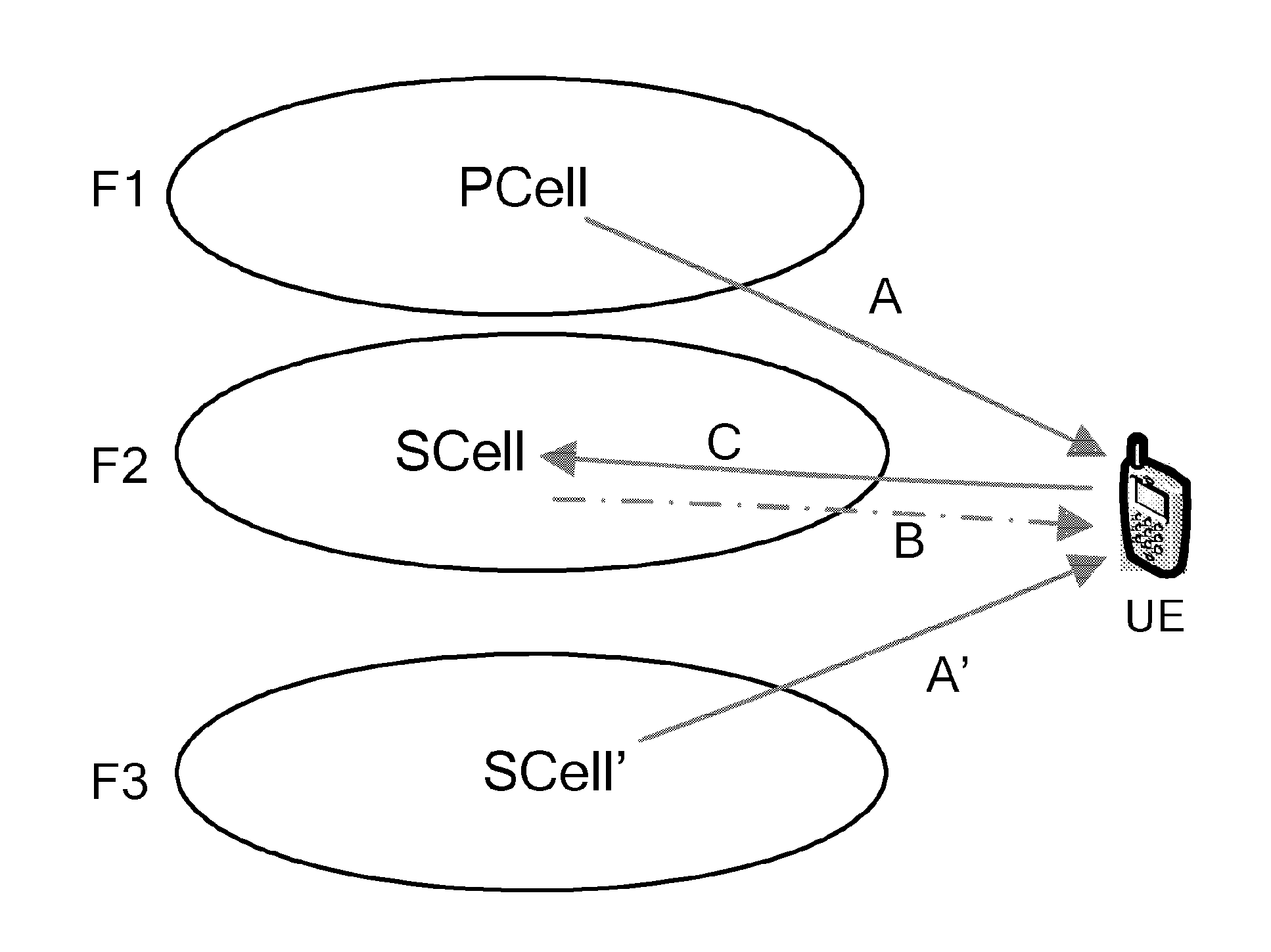Method of randomly accessing a secondary cell and receiving data
a secondary cell and data processing technology, applied in the field of random access of wireless communication, can solve the problems of reducing communication performance, not supporting the random access procedure of a scell, and the current solution cannot support the problem of scell random access
- Summary
- Abstract
- Description
- Claims
- Application Information
AI Technical Summary
Benefits of technology
Problems solved by technology
Method used
Image
Examples
embodiment 1
[0079]A UE has accessed a PCell, and set up a RRC (Radio Resource Control) connection with a serving eNB. The serving eNB configures C-RNTI for the UE, optionally, further including SPS C-RNTI. Due to the service requirement (e.g. the increase of throughput), the serving eNB needs to configure for the UE another serving cell called a SCell (comprising downlink and uplink). The SCell (the cell index is 1) belongs to a sTAG, the timing advance of the sTAG is different from the timing advance used by the pTAG to which the PCell belongs. The eNB configures, through RRC signaling, that the SCell belongs to the sTAG.
[0080]After being aware that the SCell belongs to the sTAG, the UE knows that it needs to perform random access on the SCell to obtain an uplink timing advance.
[0081]Before controlling the UE to randomly access the SCell, the serving eNB should activate the SCell. The eNB informs the UE to activate the SCell through a MAC CE (Medium Access Control Control Element).
[0082]In the...
embodiment 2
[0095]The UE sets up a RRC connection with a serving eNB. It's configured with one pTAG and two sTAGs (sTAG1 and sTAG2). And, the UE has accessed a PCell in the pTAG and a SCell′ in the sTAG1, and obtained each uplink timing advance of the pTAG and the sTAG1.
[0096]The serving eNB activates the SCell belonging to the sTAG2, and needs the UE to access the SCell.
[0097]In the case that cross-carrier scheduling exists, if it is configured that the PCell cross-carrier schedules the SCell, the PCell may transmit the random access command accessing the SCell to the UE, which is similar with the embodiment 1, illustrated as the arrow A in FIG. 1, wherein, the band occupied by the PCell (comprising uplink and downlink) is F1. If it is configured that the SCell′ cross-carrier schedules the SCell, the SCell′ in the sTAG1 may transmit the random access command to the UE, illustrated as the arrow A′ in FIG. 1, wherein, the band occupied by the SCell′ (comprising uplink and downlink) is F3. The fo...
embodiment 3
[0105]In the previous two embodiments, in order to exemplify the detailed embodiment of the random access command of a random access SCell, it uses the DCI 1A and the carrier indicator indicating the cell index of a SCell. In a varied embodiment, the carrier indicator may be not used to indicate the cell index of a random access SCell, while a new designed dedicated information element is used to indicate the random access SCell, e.g. indicating its cell index.
[0106]In another varied embodiment, there is no need for instructing the index of the SCell randomly accessed, but only need for informing the UE of randomly ac cess a SCell, and the specific SCell to be accessed is determined by the UE itself. E.g. the carrier indicator is set to other specific value other than 0, such as 1 (1 bit) or 111 (3 bits), to represent that the DCI 1A is used for instructing randomly accessing SCell. Or, other information element in the DCI 1A, e.g. the modulation and coding scheme is set to 11111 or...
PUM
 Login to View More
Login to View More Abstract
Description
Claims
Application Information
 Login to View More
Login to View More - R&D
- Intellectual Property
- Life Sciences
- Materials
- Tech Scout
- Unparalleled Data Quality
- Higher Quality Content
- 60% Fewer Hallucinations
Browse by: Latest US Patents, China's latest patents, Technical Efficacy Thesaurus, Application Domain, Technology Topic, Popular Technical Reports.
© 2025 PatSnap. All rights reserved.Legal|Privacy policy|Modern Slavery Act Transparency Statement|Sitemap|About US| Contact US: help@patsnap.com


